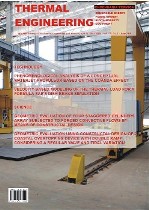DEVELOPMENT OF A NUMERICAL MODEL FOR THE STUDY OF AN OSCILLATING WATER COLUMN DEVICE CONSIDERING AN IMPULSE TURBINE
DOI:
https://doi.org/10.5380/reterm.v18i1.67057Palavras-chave:
oscillating water column, impulse turbine, numerical study, turbulent flowResumo
The present work brings a numerical study of an energy conversion device which takes energy from the waves through an oscillating water column (OWC), considering an impulse turbine with rotation in the chimney region through the implementation of a movable mesh model. More precisely, a turbulent, transient and incompressible air flow is numerically simulated in a two-dimensional domain, which mimics an OWC device chamber. The objectives are the verification of the numerical model with movable mesh of the impulse turbine in the free domain from the comparison with the literature and, later, the study of the impulse turbine inserted in the geometry of the OWC device. In order to perform the numerical simulation on the generated domains, the Finite Volume Method (FVM) is used to solve the mass and momentum conservation equations. For the closure of the turbulence, the URANS (Unsteady Reynolds Averaged Navier-Stokes) model k-ω SST is used. To verify the numerical model employed, drag coefficients, lift, torque and power are obtained and compared with studies in the literature. The simulations are performed considering a flow with a Reynolds number of ReD = 867,000, air as the working fluid and a tip speed ratio of λ = 2. For the verification case, coefficients similar to those previously predicted in the literature were obtained. For the case where the OWC device was inserted it was possible to observe an intensification of the field of velocities in the turbine region, which led to an augmentation in the magnitude of all coefficients investigated (drag, lift, torque and power). For the case studied with the tip velocity ratio λ = 2, results indicated that power coefficient was augmented, indicating that the insertion of the turbine in a closed enclosure can benefit the energy conversion in an OWC device.
Downloads
Publicado
Como Citar
Edição
Seção
Licença
Direitos Autorais para artigos publicados nesta revista são do autor, com direitos de primeira publicação para a revista. Em virtude da aparecerem nesta revista de acesso público, os artigos são de uso gratuito, com atribuições próprias, em aplicações educacionais e não-comerciais.



